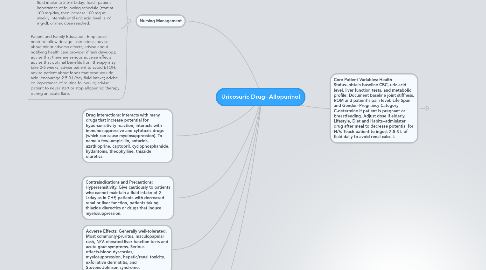Uricosuric Drug--Allopurinol
by Antigone Pantanizopoulos

1. Pharmacotherapeutics: Chronic gout, recureent calcium renal stones and hyperuricemia r/t to cancer or tumor lysis syndrome. Off-label uses-several=prevention of ischemic reperfusion tissue damage and arrythmias, decrease in H. pylori induced duodenal ulcer recurrence rates, treatment of hematemesis from NSAID induced erosive gastritis.
2. Pharmacokinetics: Given orally or IV. Orally- ~90% is absorbed. Widely distributed except to CNS. Undergoes hepatic metabolism and rapidly oxidized to oxypurinol=both have renal elimination.
3. Contraindications and Precautions: Hypersensitivity. Give cautiously to patients who cannot maintain a fluid intake of 2 L/day as in CHF, patients with decreased renal or liver function, patients taking thiazide diurectics or drugs that induce myelosuppression.
4. Adverse Effects: Generally well-tolerated. Most commonly-pruritus, maculopapular rash, N/V, elevated liver function tests and acute gout symptoms. Serious effects-blood dyscrasias, myelosuppression, hepatic/renal toxicity, exfoliative dermatitis, and Stevens-Johnson syndrome.
5. Drug Interactions: interacts with many drugs that increase potential for hypersensitivity reaction, interacts with immunosuppressive and cytotoxic drugs (which can cause myelosuppression). To name a few--ampicillin, antacids, azathioprine, captopril, cyclophosphamide, hydantoins, theophylline, thiazide diuretics.
6. Nursing Management
6.1. Maximizing Therapeutic Effects: Administer with colchicine to decrease potential for gout flare-up, initially. Teach patient about meals that decrease uric acid production (limit consumption of meat products and seafood, alcohol and beer; encourage purine-rich vegetables and dairy intake).
6.2. Minimizing Adverse Effects: Administer drug after meals to decrease N/V. Encourage fluid intake to 2.5-3 L/day. Teach patient importance of following schedule (start at 100 mg/day, then increase 100 mg at weekly intervals until uric acid level is <6 mg/dL or max dose reached.
6.3. Patient and Family Education: Emphasize need to follow dosage instructions; advise about minor adverse effects; advise about notifying health care provider if rash develops; advise that there are serious adverse effects; advise that optimal benefits from therapy may take 2-6 weeks; advise patient to avoid ETOH; advise patient about foods that produce uric acid; encourage 2.5-3 L/day fluid intake; advise on importance of routine follow-up; advise patient to never start or stop allopurinol therapy during an acute flare.
7. Core Patient Variables: Health Status--obtain baseline CBC, uric acid level, liver function tests, and metabolic profile. Document baseline joint stiffness, ROM and patient's pain level. Life Span and Gender--Pregnancy Category C-determine if patient is pregnant or breastfeeding. Adjust dose if elderly. Lifestyle, Diet and Habits--administer drug after meal to decrease potential for N/V. Teach patient to ingest 2.5-3 L of fluid daily to avoid renal calculi.
7.1. New node


